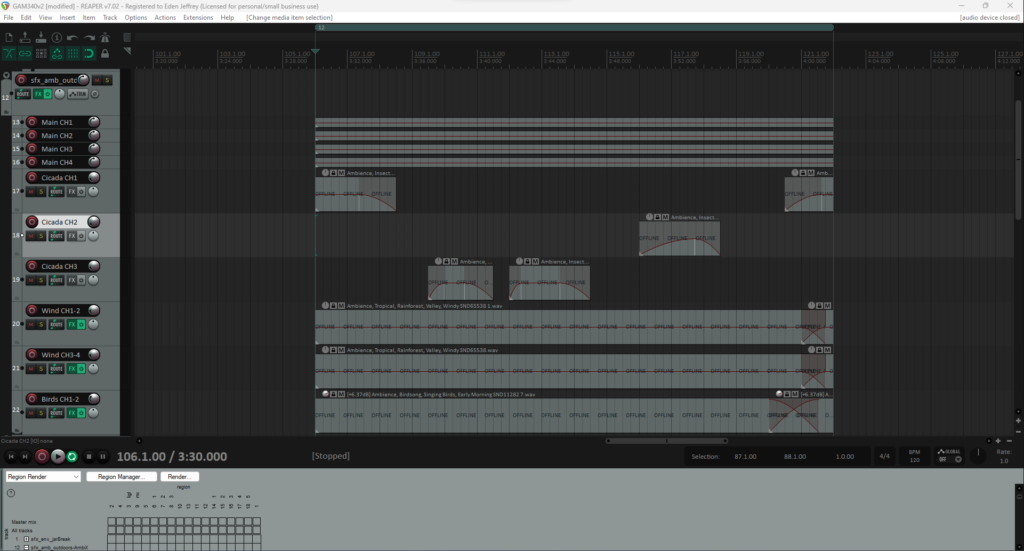Project Introduction
This project aims to demonstrate the implementation of the Wwise spatial audio pipeline within a UE5.1 example environment. This demonstration will showcase how Wwise spatial audio features such as Rooms and Portals can be utilized to create adaptive ambiences and spatialize audio sources with diffraction and transmission.
In addition, I will be demonstrating solutions for common audio implementation challenges such as spline-based audio emission and physical surface type detection for player locomotion. Both the creative and technical processes (audio design and implementation with C++ and Blueprint) will be documented in this series of posts
A full project statement can be downloaded below:
Side note: Due to restrictions on media items in the free version of Wwise, the scope of audio assets had to be reduced, and the fidelity of the locomotion system reduced to compensate. Despite these setbacks, I still feel this project is successful at demonstrating my technical skills and my capacity for learning.
Demo Walkthrough
Downloads
Download the build, and other documentation here
Audio Design
The audio design process for this project was focused primarily on creating assets that blended together to create an immersive soundscape. This required carefully selecting and processing source audio to create seamless loops free from distinctive signatures, whilst retaining detail.
For this project I primarily used REAPER as my DAW, the batch processing features and ReWwise integration were essential to a workflow processing high quantities of asset variations.
Working with Ambisonics
Ambisonics is a technique for providing multiple audio channels to represent both horizontal and vertical planes. Used commonly in surround sound and VR, Ambisonics creates a more spherical sound representation, providing a listener with significantly more directionality.
Ambisonics audio is stored in a range of formats, one of which being “AmbiX”. AmbiX is one of the Ambisonics formats available to use in Wwise, and is the format I have designed my ambiences to be converter to.

In REAPER, I have used multichannel tracks to route various sub-tracks into, allowing layering on a per-channel basis. Each channel has a slightly different base tone, to provide directionality, as well as sweeteners such as cicadas and birds, routed into either single channels, or dual channels (left/right, up/down). These sweeteners, along with directional wind, create an immersive ambience, that when used as Wwise room tones provide directionality and depth to an environment’s soundscape.

Stereo audio is routed into the CH1/2 of the multichannel ambisonics track, and shown how with careful sample selection, editing and mixing only small EQ tweaks need to be made to each ambience layer. In the above example, I have applied a band-pass filter to around 5000kHz~ to cut out a fatiguing resonant frequency.
Beach Ambience AmbiX
Locomotion Audio Design
In this project a primary goal was realism and immersion, as traversing was a significant aspect of the demo, I could justify using numerous assets for the various locomotions, states, speeds and surface types. Typically, footsteps are implemented as stompy, short steps that are triggered with each footstep. In reality, walking and running are much more flowing and rhythmic, opposed to harshly defined impacts.

To better represent player locomotion, I divided the walking cycles into “footsteps” and “footlifts”. This allowed a greater degree of freedom when mixing to create a more shuffling, constant sound of motion, rather than something percussion-esque. Although in my case this doubled the number of assets in use (for a greater degree of artistic control), it could be achieved by cropping and fading the existing footstep samples in Wwise.

A simple way to add significantly more variation to locomotion audio is through layering clothing sounds along with the footsteps. In the above example I have created clothing layers for: cloth, chain, and armour; these layers can all be randomized to create thousands of unique variations.
I’ve split these clothing layers into “Short” and “Medium”. These group represent the tail length for the assets, with short tails being used for high locomotion speeds, and medium tail lengths for low speeds.
